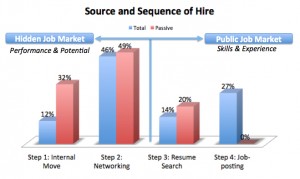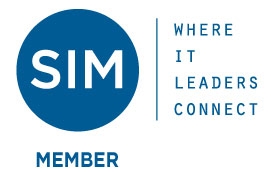
[Reposting Lou Adler’s* commentary which explained the broken hiring process for which we offer a measureable solution.]
There are two job markets: one that works, and one that doesn’t.
The dismal U.S. hiring report that came out last week was describing the one that doesn’t work. It’s inefficient and frustrating for both the talent hunter and job-seeker. It’s where jobs are filled, not where careers are started. The one that works, while not publicized, is in plain sight, and it’s where all of the good jobs and good people are found.
Describing the hiring rules for this not-so-hidden job market was my main purpose for writing The Essential Guide for Hiring & Getting Hired. But figuring out the rules starts by understanding the differences in the two job markets. A survey we’re now conducting to identify source of hire will help clarify this. The results of over 1,500 respondents are summarized in the graphic.
The non-public, hidden and more effective market is on the left consisting primarily of internal moves and networking. In this market candidates are evaluated primarily on their past performance and future potential. This is a good thing since it opens up the doors to strong talent of all age groups with a different mix of skills, more diverse candidates, high potential candidates who are light on skills, and returning military veterans. The public and less effective market is on the right emphasizing job postings and resume matching. In this job market candidates are screened and evaluated on their skills, experiences and academics. This is not good since the implication is that you must be both fully qualified and willing to take a lateral transfer. The hidden market is huge: over half of (58%) of active candidates found jobs in this market, and an astonishing 81% of passive candidates found new jobs here.
The sequence of steps hiring managers use to fill jobs helps understand how the two job markets are created, and why they’re different. As managers ponder the idea of adding staff, they don’t typically start by preparing a detailed job requisition and posting the job for the public to see. Instead, using just general criteria they first consider people they know internally or have worked with previously. Next they start networking, seeking out recommendations from trusted sources. The focus of these two first steps is to hire the best person possible for the role. In many cases the jobs will be modified to not only attract the person, but also to take ensure a better fit.
If suitable candidates aren’t found in these first two steps, managers will reluctantly prepare the official job description and make the opening public. Their reluctance here is that once the formal requisition is opened and blessed by the compensation department, there is less flexibility, with skills and experience dominating the assessment process.
The big picture emerging from this small survey is that there are two fundamentally different hiring processes a play at most companies: one that works and one that doesn’t. Unfortunately it’s the one that doesn’t work that is advocated by HR, legal and the compensation group. The one that works is based on finding people who are known and judged on their performance and potential. Not only is this approach more predictable from an assessment standpoint, it also produces the best talent. Even better: it’s fully compliant with all U.S. labor laws. (David Goldstein a top labor attorney with Littler Mendelson prepared a white paper for The Essential Guide for Hiring & Getting Hired that fully validates the legality of this approach.)
The process that doesn’t work is based on attracting and finding people who possess some arbitrary level of skills and experiences. Not only is this approach less predictable in terms of subsequent performance, it produces far less talent, since the best people are filtered out on the wrong criteria. Worse, since people aren’t hired on their motivation to do the actual work, job satisfaction is less and turnover is higher.
Surprisingly, this obvious difference is lost on those designing and implementing the hiring processes used at most companies today. Maybe that’s why the best hiring managers don’t formally post their jobs until they find someone worthy or until they’re desperate, and why savvy job-seekers use the back door to find jobs.
______________________________________________________
*Lou Adler (@LouA) is the Amazon best-selling author of Hire With Your Head (Wiley, 2007) and the award-winning Nightingale-Conant audio program, Talent Rules! His latest book, The Essential Guide for Hiring & Getting Hired, is now available as an Amazon Kindle eBook. You might want to join Lou’s new LinkedIn group to discuss hiring related issues.













Comments are closed.